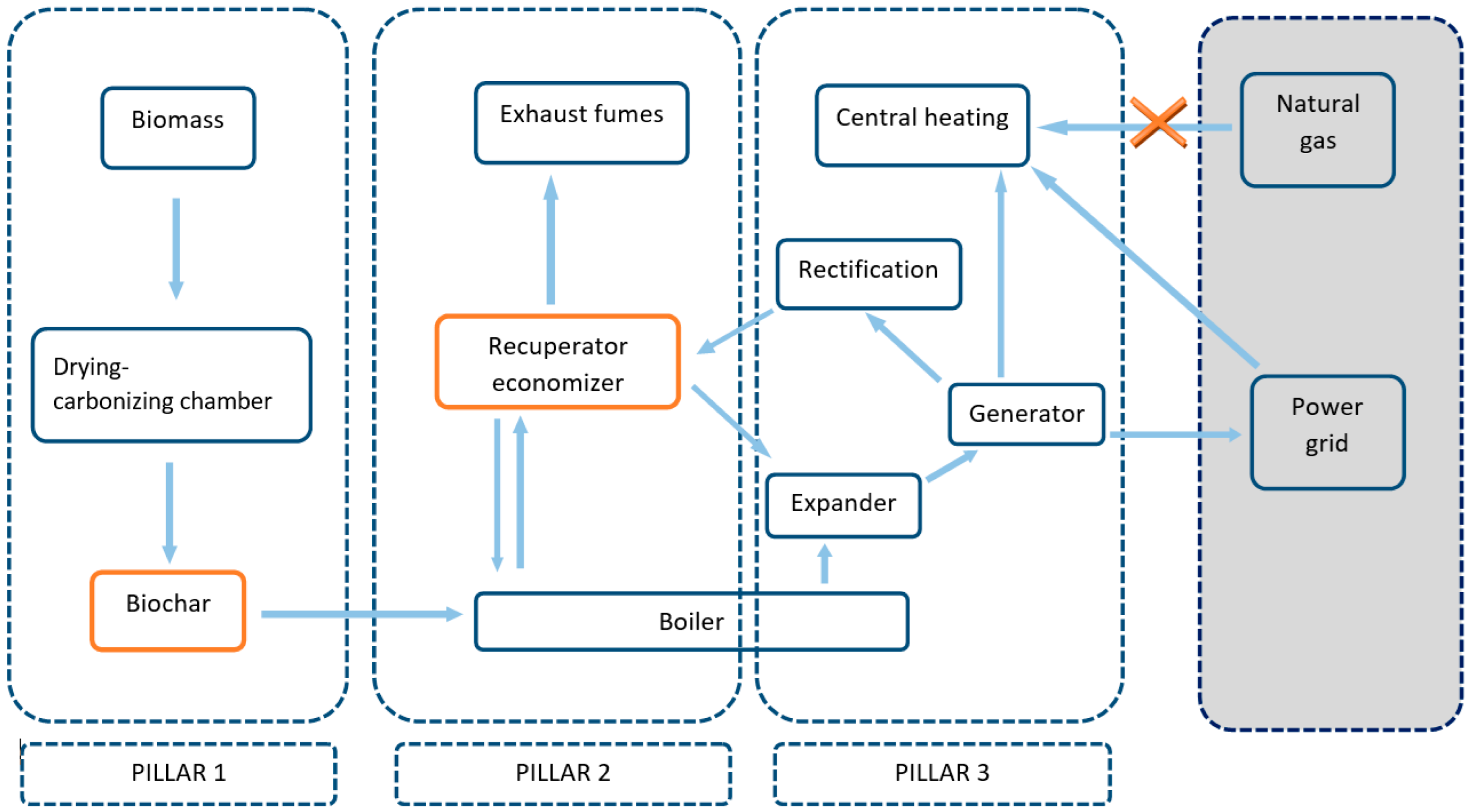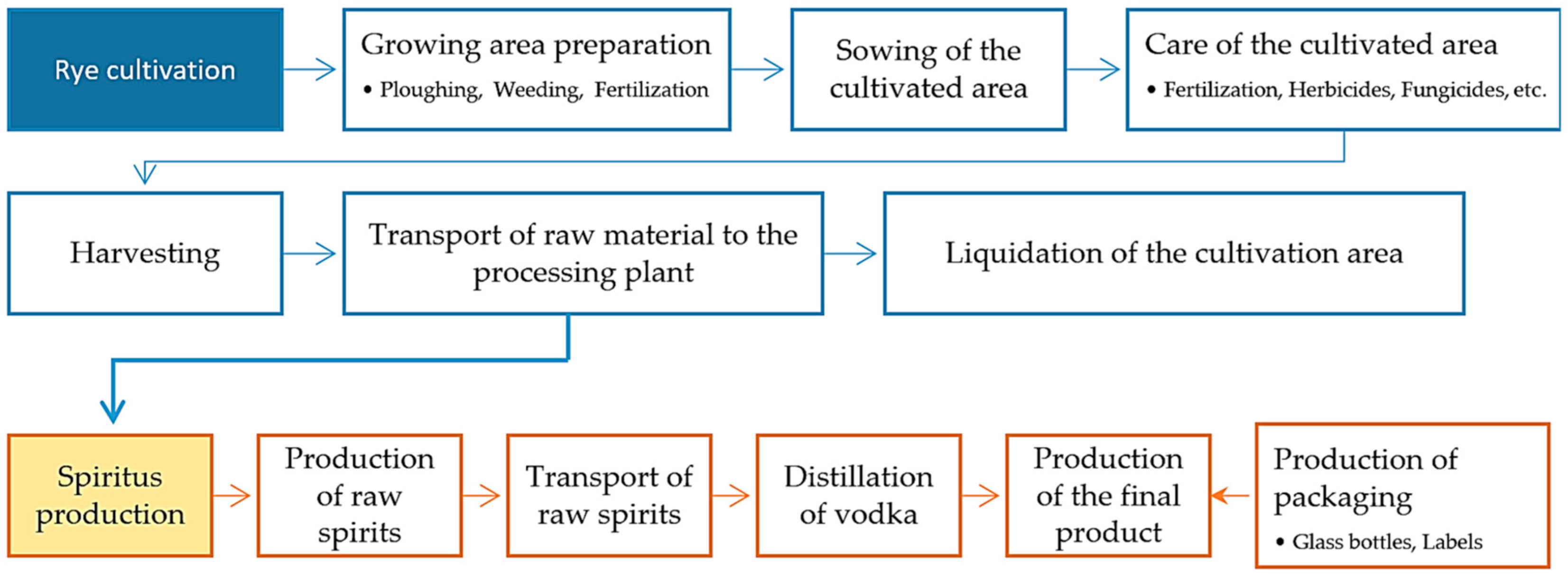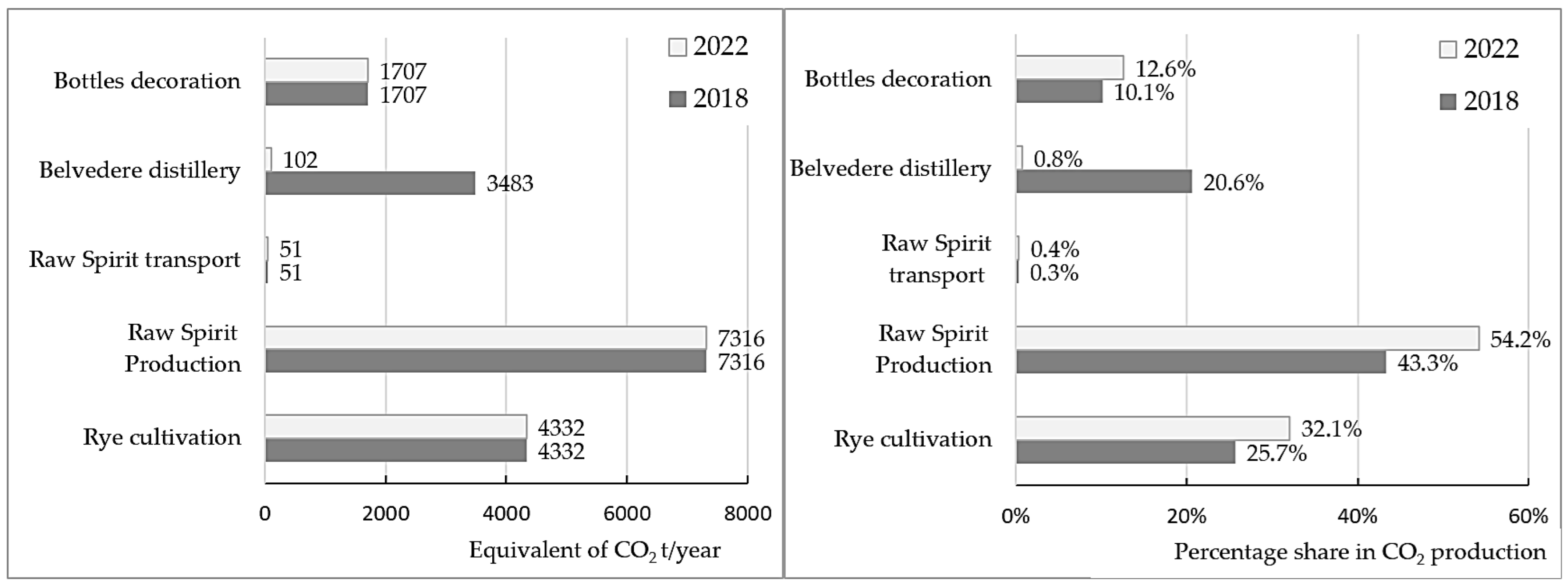Renewable Energy Sources and Improved Energy Management as a Path to Energy Transformation: A Case Study of a Vodka Distillery in Poland
Abstract
1. Introduction
2. Materials and Methods
3. Results
3.1. Installation for Biomass-Based Energy Production
- -
- biomass energy generation efficiency for the reference system: ηref = 87%,
- -
- biomass energy generation efficiency of the analysed system: η = 120%,
3.2. Environmental Effect of the Modernisation
4. Conclusions
Author Contributions
Funding
Institutional Review Board Statement
Informed Consent Statement
Data Availability Statement
Conflicts of Interest
References
- Mark, N. Four Degrees and beyond: The Potential for a Global Temperature Increase of Four Degrees and its Implications. Phil. Trans. R. Soc. A. 2011, 369, 4–5. [Google Scholar] [CrossRef]
- Jordan, A.; Rayner, T. The Evolution of Climate Policy in the European Union: An Historical Overview. In Climate Change Policy in the European Union: Confronting the Dilemmas of Mitigation and Adaptation; Cambridge University Press: Cambridge, UK, 2010; pp. 52–80. [Google Scholar] [CrossRef]
- Communication on The European Green Deal—European Commission. Available online: https://commission.europa.eu/publications/communication-european-green-deal_en (accessed on 10 October 2024).
- Directive-EU-2023/2413-EN-Renewable Energy Directive-EUR-Lex. Available online: https://eur-lex.europa.eu/legal-content/EN/TXT/?trk=feed_main-feed-card_feed-article-content&uri=OJ%3AL_202302413 (accessed on 25 October 2024).
- BP Statistical Review of World Energy 2021—Global; BP: London, UK, 2021.
- Energy Statistics—An Overview—Statistics Explained. Available online: https://ec.europa.eu/eurostat/statistics-explained/index.php?title=Energy_statistics_-_an_overview#Primary_energy_production (accessed on 10 October 2024).
- Transformacja Energetyczna w Polsce. Edycja 2024—Forum Energii. Available online: https://www.forum-energii.eu/transformacja-edycja-2024 (accessed on 10 October 2024).
- Zeng, Q.; Lu, Q.; Zhou, Y.; Chen, N.; Rao, J.; Fan, M. Circular Development of Recycled Natural Fibers from Medium Density Fiberboard Wastes. J. Clean. Prod. 2018, 202, 456–464. [Google Scholar] [CrossRef]
- Wojtacha-Rychter, K.; Smoliński, A. Multi-Case Study on Environmental and Economic Benefits through Co-Burning Refuse-Derived Fuels and Sewage Sludge in Cement Industry. Materials 2022, 15, 4176. [Google Scholar] [CrossRef] [PubMed]
- Clean Energy for All Europeans—Unlocking Europe’s Growth Potential. Available online: https://ec.europa.eu/commission/presscorner/detail/en/ip_16_4009 (accessed on 24 October 2024).
- Raport-Zbiorcze Informacje Dotyczące Wytwarzania Energii Elektrycznej z Odnawialnych Źródeł Energii w Małej Instalacji (Art. 17 Ustawy o Odnawialnych Źródłach Energii)-Raport OZE-Art. 17 Ustawy OZE-BIP-Urząd Regulacji Energetyki. Available online: https://bip.ure.gov.pl/bip/o-urzedzie/zadania-prezesa-ure/raport-oze-art-17-ustaw/3556,Raport-zbiorcze-informacje-dotyczace-wytwarzania-energii-elektrycznej-z-odnawial.html (accessed on 10 October 2024).
- Ustawa z Dnia 20 Lutego 2015 r. o Odnawialnych Źródłach Energii. Available online: https://isap.sejm.gov.pl/isap.nsf/DocDetails.xsp?id=wdu20150000478 (accessed on 25 October 2024).
- Hahn-Hägerdal, B.; Galbe, M.; Gorwa-Grauslund, M.F.; Lidén, G.; Zacchi, G. Bio-Ethanol—The Fuel of Tomorrow from the Residues of Today. Trends Biotechnol. 2006, 24, 549–556. [Google Scholar] [CrossRef]
- Abdeshahian, P.; Kadier, A.; Rai, P.K.; da Silva, S.S. Lignocellulose as a Renewable Carbon Source for Microbial Synthesis of Different Enzymes. In Lignocellulosic Biorefining Technologies; Wiley: Hoboken, NJ, USA, 2020; pp. 185–202. [Google Scholar] [CrossRef]
- Parakh, P.D.; Nanda, S.; Kozinski, J.A. Eco-Friendly Transformation of Waste Biomass to Biofuels. Curr. Biochem. Eng. 2020, 6, 120–134. [Google Scholar] [CrossRef]
- Morey, R.V.; Hatfield, D.L.; Sears, R.; Haak, D.; Tiffany, D.G.; Kaliyan, N. Fuel Properties of Biomass Feed Streams at Ethanol Plants. Appl. Eng. Agric. 2009, 25, 57–64. [Google Scholar] [CrossRef]
- Weber, B.; Stadlbauer, E.A. Sustainable Paths for Managing Solid and Liquid Waste from Distilleries and Breweries. J. Clean. Prod. 2017, 149, 38–48. [Google Scholar] [CrossRef]
- Kosakowski, W.; Bryszewska, M.A.; Dziugan, P. Biochars from Post-Production Biomass and Waste from Wood Management: Analysis of Carbonization Products. Materials 2020, 13, 4971. [Google Scholar] [CrossRef]
- Lin, J.C.-T.; Liu, Y.S.; Wang, W.K. A Full-Scale Study of High-Rate Anaerobic Bioreactors for Whiskey Distillery Wastewater Treatment with Size Fractionation and Metagenomic Analysis of Granular Sludge. Bioresour. Technol. 2020, 306, 123032. [Google Scholar] [CrossRef]
- Igliński, B.; Skrzatek, M.; Kujawski, W.; Cichosz, M.; Buczkowski, R. SWOT Analysis of Renewable Energy Sector in Mazowieckie Voivodeship (Poland): Current Progress, Prospects and Policy Implications. Environ. Dev. Sustain. 2022, 24, 77–111. [Google Scholar] [CrossRef]
- Heliex Power—Turn Your Steam into Cash. Available online: https://www.heliexpower.com/technology (accessed on 10 July 2025).
- ISO 14040:2006; Environmental Management—Life Cycle Assessment—Principles and Framework. ISO: Geneva, Switzerland, 2006.
- ISO/TR 14049:2012; Environmental Management—Life Cycle Assessment—Illustrative Examples on How to Apply ISO 14044 to Goal and Scope Definition and Inventory Analysis. ISO: Geneva, Switzerland, 2012.
- Hiloidhari, M.; Haran, S.; Banerjee, R.; Rao, A.B. Life Cycle Energy-Carbon-Water Footprints of Sugar, Ethanol and Electricity from Sugarcane. Bioresour. Technol. 2021, 330, 125012. [Google Scholar] [CrossRef]
- Guzman-Bustamante, I.; Winkler, T.; Schulz, R.; Müller, T.; Mannheim, T.; Laso Bayas, J.C.; Ruser, R. N2O Emissions from a Loamy Soil Cropped with Winter Wheat as Affected by N-Fertilizer Amount and Nitrification Inhibitor. Nutr. Cycl. Agroecosyst. 2019, 114, 173–191. [Google Scholar] [CrossRef]
- Lienhardt, T.; Black, K.; Saget, S.; Costa, M.P.; Chadwick, D.; Rees, R.; Williams, M.; Spillane, C.; Iannetta, P.; Walker, G.; et al. Data for Life Cycle Assessment of Legume Biorefining for Alcohol. Data Brief 2019, 25, 104242. [Google Scholar] [CrossRef]
- Roy, P.; Dutta, A. Life Cycle Assessment (LCA) of Bioethanol Produced from Different Food Crops: Economic and Environmental Impacts. In Bioethanol Production from Food Crops; Academic Press: Cambridge, MA, USA, 2019; pp. 385–399. [Google Scholar] [CrossRef]
- Bamber, N.; Johnson, R.; Laage, E.; Dias, G.; Tyedmers, P.; Pelletier, N. Life Cycle Inventory and Emissions Modelling in Organic Field Crop LCA Studies: Review and Recommendations. Resour. Conserv. Recycl. 2022, 185, 106465. [Google Scholar] [CrossRef]
- Numjuncharoen, T.; Papong, S.; Malakul, P.; Mungcharoen, T. Life-Cycle GHG Emissions of Cassava-Based Bioethanol Production. Energy Procedia 2015, 79, 265–271. [Google Scholar] [CrossRef]
- Rozporządzenie Ministra Klimatu z Dnia 24 Września 2020 r. w Sprawie Standardów Emisyjnych Dla Niektórych Rodzajów Instalacji, Źródeł Spalania Paliw Oraz Urządzeń Spalania Lub Współspalania Odpadów. Available online: https://isap.sejm.gov.pl/isap.nsf/DocDetails.xsp?id=WDU20200001860 (accessed on 25 October 2024).
- Directive—2015/2193—EN—EUR-Lex. Available online: https://eur-lex.europa.eu/legal-content/EN/TXT/?uri=CELEX%3A32015L2193 (accessed on 25 October 2024).
- Adelekan, O.A.; Ilugbusi, B.S.; Adisa, O.; Obi, O.C.; Awonuga, K.F.; Asuzu, O.F.; Ndubuisi, N.L. Energy Transition Policies: A Global Review of Shifts Towards Renewable Sources. Eng. Sci. Technol. J. 2024, 5, 272–287. [Google Scholar] [CrossRef]
- Yearbook—Energy Data—Forum Energii. Available online: https://www.forum-energii.eu/en/yearbook-energy-data-1 (accessed on 1 November 2024).
- Data View. Available online: https://transparency.entsoe.eu/generation/r2/installedGenerationCapacityAggregation/show?name=&defaultValue=false&viewType=TABLE&areaType=CTY&atch=false&dateTime.dateTime=01.01.2023+00:00%7CUTC%7CYEAR&dateTime.endDateTime=&area.values=CTY%7C10YPL-AREA-----S!CTY%7C10YPL-AREA-----S&productionType.values=B01&productionType.values=B02&productionType.values=B03&productionType.values=B04&productionType.values=B05&productionType.values=B06&productionType.values=B07&productionType.values=B08&productionType.values=B09&productionType.values=B10&productionType.values=B11&productionType.values=B12&productionType.values=B13&productionType.values=B14&productionType.values=B20&productionType.values=B15&productionType.values=B16&productionType.values=B17&productionType.values=B18&productionType.values=B19 (accessed on 1 November 2024).
- Tokarski, S.; Magdziarczyk, M.; Smoliński, A. An Analysis of Risks and Challenges to the Polish Power Industry in the Year 2024. Energies 2024, 17, 1044. [Google Scholar] [CrossRef]
- Joița, D.; Panait, M.; Dobrotă, C.E.; Diniță, A.; Neacșa, A.; Naghi, L.E. The European Dilemma—Energy Security or Green Transition. Energies 2023, 16, 3849. [Google Scholar] [CrossRef]
- Prokopenko, O.; Kurbatova, T.; Khalilova, M.; Zerkal, A.; Prause, G.; Binda, J.; Berdiyorov, T.; Klapkiv, Y.; Sanetra-Półgrabi, S.; Komarnitskyi, I. Impact of Investments and R&D Costs in Renewable Energy Technologies on Companies’ Profitability Indicators: Assessment and Forecast. Energies 2023, 16, 1021. [Google Scholar] [CrossRef]
- Caglayan, R.Z.; Kayisli, K.; Zhakiyev, N.; Harrouz, A.; Colak, I. A Case Study: Standalone Hybrid Renewable Energy Systems. In Proceedings of the 11th International Conference on Renewable Energy Research and Application (ICRERA), Istanbul, Turkey, 18–21 September 2022; pp. 284–292. [Google Scholar] [CrossRef]
- Oğuz, C.; Güğül, G.N. A Comparative Configuration and Decision of Main Restrictions of a Renewable Energy Powered Campus Micro Grid: A Case Study. Energy Build. 2024, 322, 114685. [Google Scholar] [CrossRef]
- Proskurina, S.; Heinimö, J.; Schipfer, F.; Vakkilainen, E. Biomass for Industrial Applications: The Role of Torrefaction. Renew. Energy 2017, 111, 265–274. [Google Scholar] [CrossRef]
- Lewandowski, W.M.; Ryms, M.; Kosakowski, W. Thermal Biomass Conversion: A Review. Processes 2020, 8, 516. [Google Scholar] [CrossRef]
- Mignogna, D.; Szabó, M.; Ceci, P.; Avino, P. Biomass Energy and Biofuels: Perspective, Potentials, and Challenges in the Energy Transition. Sustainability 2024, 16, 7036. [Google Scholar] [CrossRef]
- Ribeiro, J.M.C.; Godina, R.; de Matias, J.C.O.; Nunes, L.J.R. Future Perspectives of Biomass Torrefaction: Review of the Current State-Of-The-Art and Research Development. Sustainability 2018, 10, 2323. [Google Scholar] [CrossRef]
- Ciolkosz, D.; Wallace, R. A Review of Torrefaction for Bioenergy Feedstock Production. Biofuels Bioprod. Biorefin. 2011, 5, 317–329. [Google Scholar] [CrossRef]
- Mpungu, I.L.; Maube, O.; Nziu, P.; Mwasiagi, J.I.; Dulo, B.; Bongomin, O. Optimizing Waste for Energy: Exploring Municipal Solid Waste Variations on Torrefaction and Biochar Production. Int. J. Energy Res. 2024, 2024, 4311062. [Google Scholar] [CrossRef]
- Nussbaumer, T. Aerosols from Biomass Combustion: Technical Report on Behalf of the IEA Bioenergy Task 32; IEA Bioenergy: Luzern, Switzerland, 2017. [Google Scholar]
- Schulte, S.; Heinzle, J.; Groß, B. Reduction of Particulate Matter Emissions from a Pellet Boiler Using Primary Measures. Chem. Eng. Technol. 2020, 43, 1506–1513. [Google Scholar] [CrossRef]
- Huang, H.; Gao, Y.; Chen, H.; Wu, Y.; Wang, J.; Yu, C.; Li, J.; Zou, C. Biomass Briquette Fuel, Boiler Types and Pollutant Emissions of Industrial Biomass Boiler: A Review. Particuology 2023, 77, 79–90. [Google Scholar] [CrossRef]
- Johansen, J.M.; Jakobsen, J.G.; Frandsen, F.J.; Glarborg, P. Release of K, Cl, and S during Pyrolysis and Combustion of High-Chlorine Biomass. Energy Fuels 2011, 25, 4961–4971. [Google Scholar] [CrossRef]
- Nussbaumer, T. Combustion and Co-Combustion of Biomass: Fundamentals, Technologies, and Primary Measures for Emission Reduction. Energy Fuels 2003, 17, 1510–1521. [Google Scholar] [CrossRef]
- Kosakowski, W. Zastosowanie Innowacyjnego Systemu Skojarzonej Gospodarki Cieplnej i Elektrycznej Wykorzystujacego Paliwa Biomasowe w Celu Podniesienia Sprawności Energetycznej Instalacji Gorzelniczej w Zakładzie Polmos Żyrardów. Ph.D. Thesis, Politechnika Łódzka, Łódz, Poland, 2022. [Google Scholar]
- Bio-Energy Plants Transform Whisky Distillery Sector. Filtr. Sep. 2016, 53, 18–19. [CrossRef]
- Andrews, J.M.H.; Hancock, J.C.; Ludford-Brooks, J.; Murfin, I.J.; Houldsworth, L.; Phillips, M. 125th Anniversary Review: Some Recent Engineering Advances in Brewing and Distilling. J. Inst. Brew. 2011, 117, 23–32. [Google Scholar] [CrossRef]
- Scottish Distillery to Utilize Biomass Power | Biomass Magazine. Available online: https://biomassmagazine.com/articles/scottish-distillery-to-utilize-biomass-power-2305 (accessed on 4 November 2024).
- Whisky By-Products in Renewable Energy | ClimateXChange. Available online: https://www.climatexchange.org.uk/projects/whisky-by-products-in-renewable-energy/ (accessed on 10 July 2025).
- Andrews, G.E.; Phylaktou, H.N.; Li, H.; Khan, M.; Quinonez, R.; Olanrewaju, F.O.; Maxfield, J.; Smith, S.; Wakeman, R.; Bownes, I. Whisky Decarbonisation Potential Using Bio-Waste. Fuel 2025, 380, 133188. [Google Scholar] [CrossRef]
- Absolut Vodka’s Distillery Reaches Fossil-Free Milestone Ahead of Schedule—The Absolut Group. Available online: https://theabsolutgroup.com/media-room/press-release/absolut-vodkas-distillery-reaches-fossil-free-milestone-ahead-of-schedule/ (accessed on 8 July 2025).
- Irish Distillers Announces Plans for Midleton Distillery to Become Carbon Neutral by 2026, Using Break-through Emissions Reducing Technology | Pernod Ricard. Available online: https://www.pernod-ricard.com/en/media/irish-distillers-announces-plans-midleton-distillery-become-carbon-neutral-2026-using-break (accessed on 10 July 2025).
- Diageo Opens Its First Carbon-Neutral Whiskey Distillery in North America | Diageo. Available online: https://www.diageo.com/en/news-and-media/press-releases/2021/diageo-opens-its-first-carbon-neutral-whiskey-distillery-in-north-america (accessed on 10 July 2025).




| Instrument and Technological Parameter | Energy Flow [kW] | Exhaust Gas Outlet Temperature [°C] | Energy Share [%] | |
|---|---|---|---|---|
| 1. Energy in fuel (biomass); Qfuel | 3996 | 100 | ||
| 2. Useful heat; Q | 4798 | |||
| 2.1. | Boiler (saturated steam boiler 5.3 t/h, 18.5 bar) | 3350 | 220 | 83.83 |
| 2.2. | Economiser (Exhaust gases/feed water 100/140 °C) | 254 | 145.7 | 6.36 |
| 2.3. | Exchanger (for heating condensate 68/95 °C) | 161 | 96 | 4.03 |
| Exchanger (for heating air 20/70 °C, 2.476 kg/s) | 124 * | 60.6 | own needs | |
| 2.4. | Exchanger (for heating water 40/55 °C) | 528 | 45 | 13.21 |
| 2.5. | Heat pump (COP = 6; heating water: 55/69 °C) | 505 | 12.64 | |
| Generated electricity (expander) to power heat pump | 84 * | own needs | ||
| Heat recovery from the refrigeration system of the rectification process (421 kW, water 55/45 °C) | ||||
| Energy generation efficiency (η = ΣQ/ΣQfuel) | 120% | |||
Disclaimer/Publisher’s Note: The statements, opinions and data contained in all publications are solely those of the individual author(s) and contributor(s) and not of MDPI and/or the editor(s). MDPI and/or the editor(s) disclaim responsibility for any injury to people or property resulting from any ideas, methods, instructions or products referred to in the content. |
© 2025 by the authors. Licensee MDPI, Basel, Switzerland. This article is an open access article distributed under the terms and conditions of the Creative Commons Attribution (CC BY) license (https://creativecommons.org/licenses/by/4.0/).
Share and Cite
Bryszewska, M.A.; Staszków, R.; Ściubak, Ł.; Domański, J.; Dziugan, P. Renewable Energy Sources and Improved Energy Management as a Path to Energy Transformation: A Case Study of a Vodka Distillery in Poland. Sustainability 2025, 17, 7652. https://doi.org/10.3390/su17177652
Bryszewska MA, Staszków R, Ściubak Ł, Domański J, Dziugan P. Renewable Energy Sources and Improved Energy Management as a Path to Energy Transformation: A Case Study of a Vodka Distillery in Poland. Sustainability. 2025; 17(17):7652. https://doi.org/10.3390/su17177652
Chicago/Turabian StyleBryszewska, Małgorzata Anita, Robert Staszków, Łukasz Ściubak, Jarosław Domański, and Piotr Dziugan. 2025. "Renewable Energy Sources and Improved Energy Management as a Path to Energy Transformation: A Case Study of a Vodka Distillery in Poland" Sustainability 17, no. 17: 7652. https://doi.org/10.3390/su17177652
APA StyleBryszewska, M. A., Staszków, R., Ściubak, Ł., Domański, J., & Dziugan, P. (2025). Renewable Energy Sources and Improved Energy Management as a Path to Energy Transformation: A Case Study of a Vodka Distillery in Poland. Sustainability, 17(17), 7652. https://doi.org/10.3390/su17177652







